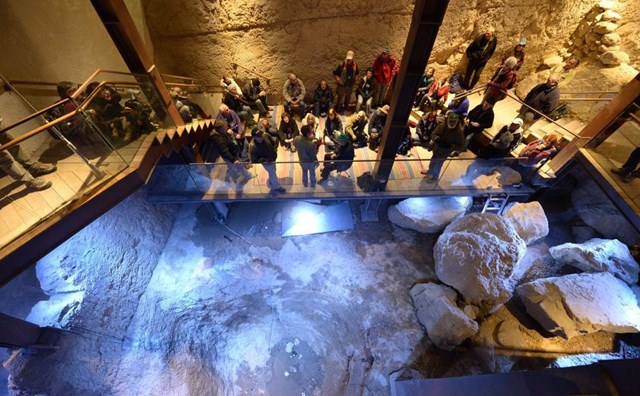The Spring Citadel was excavated in the City of David National Park by dozens of researchers led by Professor Ronny Reich of the University of Haifa and Eli Shukrun of the Israel Antiquities Authority and dated to 3,800 years ago. (City of David)
Fortified City of David tower was previously thought Canaanite
A new Weizmann Institute study has discovered radiocarbon-dating evidence of the First Temple period under a tower in Jerusalem’s City of David that was previously dated to the Canaanite period. The findings, based on soil samples taken from under a seven-meter thick walled tower, shave nearly a thousand years from previous archaeological dating of the structure, which placed it c. 1700 BCE — and contradict a presumed biblical linkage to the site.
Downhill from the Temple Mount of Jerusalem, the Gihon Spring guard tower was discovered in 2004 by archaeologists Ronny Reich and Eli Shukron. Based on pottery and architectural signifiers, the heavily fortified structure — and the rest of the Spring Citadel protecting Jerusalem’s precious water source — were dated to Canaanite construction (Middle Bronze II period).
In addition to protecting the Gihon Spring, the massive fortification served as a sort of security barrier and permitted one entrance to the spring — “from the west only, from within the city,” according to the City of David website.
“This is the largest fortress found in all of Israel to date between the Canaanite cities… and it seems that it is essentially the largest fortress found in Israel until the days of King Herod,” states the website.
However, new findings by an interdisciplinary cooperative team of Israel Antiquities Authority archaeologists and Weizmann Institute scientists place the construction of the tower during the second half of the Iron Age — smack dab in the middle of the Israelite period, and much closer to the days of Herod than earlier suspected.
Discussions on the foundation and borders of Israelite-era Jerusalem are often rife with accusations of Jewish nationalism trumping evidential facts. For those who take the Hebrew Bible literally, the Weizmann study’s findings could be difficult to reconcile with the text.
The City of David website implies that what the site has labeled the “Spring Citadel” is in fact the historical “Fortress of Zion” taken by King David from the Jebusite king, as described in the book of II Samuel, Chapter 5. Likewise, it is the location described in I Kings 1:33, when the prophet Natan and the priest Zadok anoint King Solomon “on the Gihon.”
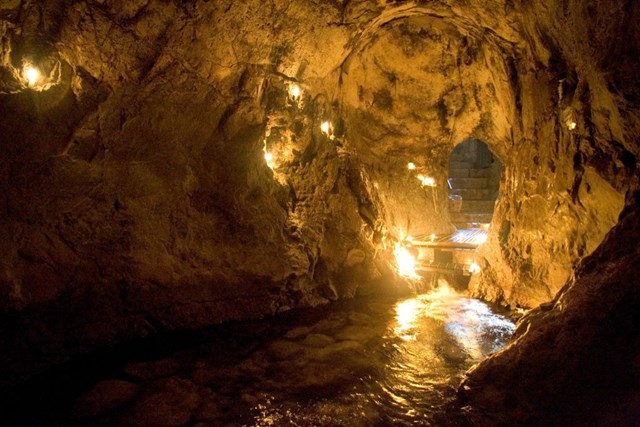
The Gihon Spring, Jerusalem’s City of David. (Tal Glick/City of David Facebook)
Most scholars place the rule of King David at c. 1005–970 BCE. The new Weizmann study’s radiocarbon dating, however, dates the construction of the Spring Citadel to after c. 900 BCE. It could not have been in existence when King David reportedly captured it, meaning it is probably not the biblical Fortress of Zion.
Sedimentary evidence
Archaeologist Shukron spent 15 years excavating the Spring Citadel, which is a centerpiece of the City of David archaeological experience. Visitors there are shown a film projected onto the Spring Citadel, and the voice-over explains the Canaanite-period construction.
Since 2012, the IAA has performed excavations along the outer, eastern face of the Spring Tower, part of the citadel. Recently, a team of archaeologists headed by Dr. Joe Uziel and Nahshon Szanton observed that the tower does not sit on bedrock but rather on layers of soil, according to the recent study, published June 6 through Cambridge University Press.
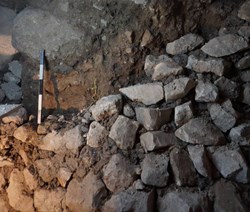
The discovery of these organically based sediment layers opened up the possibility of analyzing the soil through radiocarbon dating, rather than a dating based on the shapes and materials of discovered artifacts that was previously performed.
Left untouched and until now sealed by massive boulders at the tower’s base, the soil that was studied forms part of the structure’s foundation. Anything found below the base would predate its construction.
As part of ongoing cooperative research projects with the IAA, Dr. Elisabetta Boaretto, head of the Weizmann Institute of Science’s D-REAMS Radiocarbon Dating Laboratory and track leader within the Max Planck-Weizmann Center for Integrative Archaeology and Anthropology, was on the forefront of the radiocarbon dating analysis.
“The boulders in the tower’s base in and of themselves do not yield any information other than the fact that whoever placed them there had the ability to maneuver such heavy stones. But underneath the boulders, the soil exhibits the layers typical of archaeological strata, and these can reveal the latest date that the site was occupied before the tower was built,” said Boaretto, a nuclear physicist educated in Italy and Israel, with a PhD from Hebrew University.
Developed in the late 1940s, radiocarbon dating is carried out with the use of accelerator mass spectrometric measurements of radiocarbon, a radioactive isotope of carbon. According to the Weizmann Institute, it is precise up to ±20-40 years.
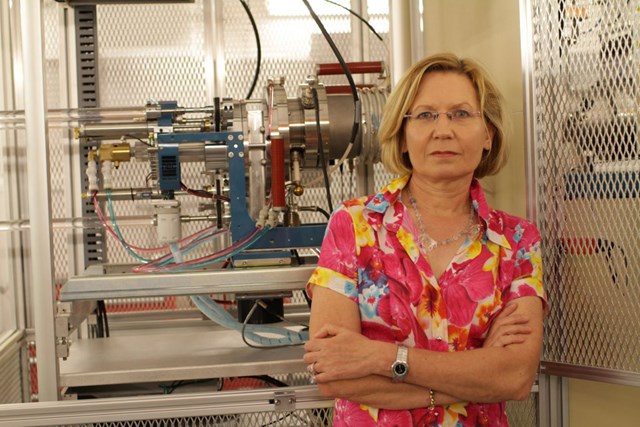
Dr. Elisabetta Boaretto, head of the Weizmann Institute of Science’s D-REAMS Radiocarbon Dating Laboratory (courtesy)
Boaretto and her postdoctoral fellow Dr. Johanna Regev identified several clearly delineated strata of sediment, from which they collected samples of charcoal, seeds and bones. According to a Weizmann Institute press release, the team can produce “highly accurate results on something as small as a seed.”
“Getting one’s hands dirty is all part of building a reliable chronology,” said Boaretto.
Two sections of sediment were sampled for radiocarbon dating beneath the foundation stones at two locations to provide “an absolute dating” for the structure, according to the study. The separate, sequential layers of sediment were identified using microarchaeological tools and radiocarbon dating, and enabled the researchers to date the strata found at the base of the tower.
The results? “Scenarios for the construction of the tower during Middle Bronze Age (MB) and Iron Age II are considered, based on the new 14C [radiocarbon] data, yielding a series of dates, the latest of which falls in the terminal phases of the 9th century BCE, alongside previous excavation data,” according to the study.
Contrary to previous estimates, the date revealed by this radiocarbon dating was sometime around 900-800 BCE — nearly 1,000 years later than archaeologists had originally dated the tower, and well after the presumed reign of King David.
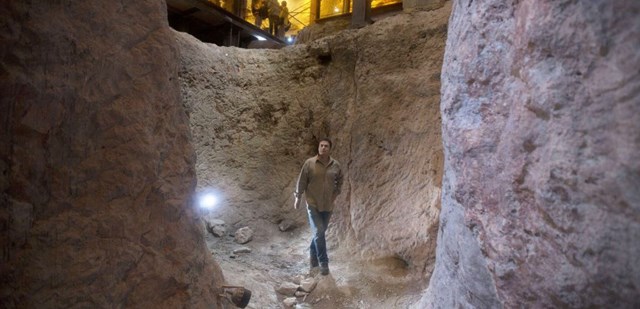
Archaeologist Eli Shukron, who claims to uncovered the citadel captured from the Jebusites by King David, walks in the City of David archaeological site near Jerusalem’s Old City on Thursday, May 1, 2014. (AP Photo/Sebastian Scheiner)
Raising and dismissing the possibility that the tower was built in the Canaanite period and reconstructed during the Israelite period, Boaretto says understatedly, “The conclusive, scientific dating of this massive tower, placing it in a later era than was presumed, will have repercussions for other attempts to date construction and occupation in ancient Jerusalem.”
How widespread the radiocarbon dating’s repercussions extend, however, is already up for debate.
Tel Aviv University archaeology Prof. Israel Finkelstein told The Times of Israel that Boaretto’s study, while interesting, is not decisive.
“I agree with one of the possibilities raised by the authors, that the radiocarbon dates come from under a restored sector of the eastern wall of the spring tower. Accordingly, the spring tower could have been built in the Middle Bronze Age and restored in the late 9th century or even later,” says Finkelstein, who is a proponent of the idea that ancient Jerusalem had smaller, more modest city limits.
According to Finkelstein, the Jacob M. Alkow professor of the Archaeology of Israel in the Bronze and Iron Ages at Tel Aviv University, “A Middle Bronze date for the original construction of the tower is supported by similarity to construction methods at places such as Shechem and Shiloh.” (Finkelstein was director of excavations at biblical Shiloh in 1981-1984.)
“If indeed an old tower was damaged and restored in the Iron Age, the question is when. The radiocarbon dates only mean that this could not have been done before the late 9th century. A later date is still possible,” he says.
“In any event, a late 9th century date should come as no surprise, as there are other indications for the growth of the city at that time – from the Temple Mount (in my opinion the original location of the mound of Jerusalem) to the south, in the direction of the Gihon spring,” says Finkelstein.
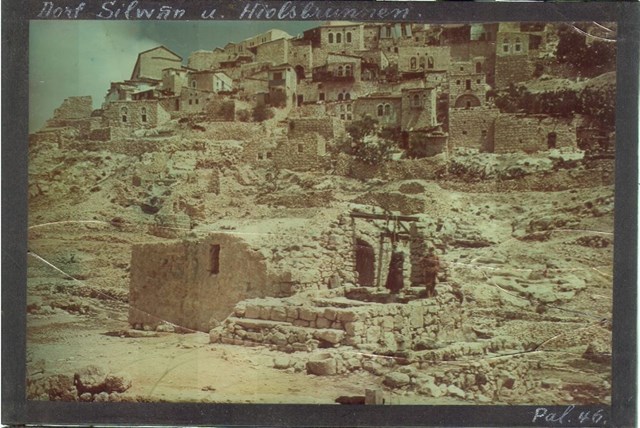
A well in Silwan, outside Jerusalem’s city walls (undated) (photo credit: © DEIAHL, Jerusalem)

